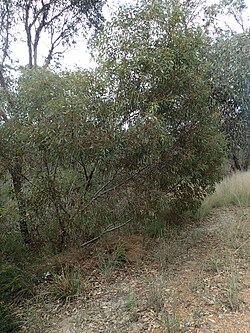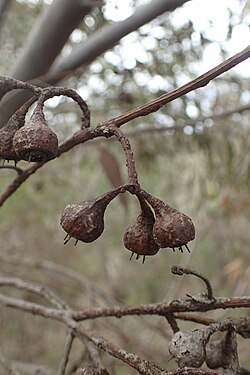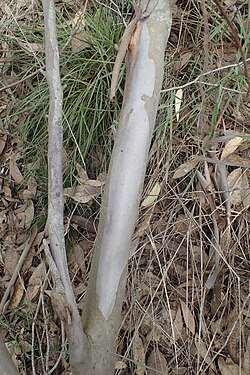Biology:Eucalyptus × balanopelex
| Eucalyptus × balanopelex | |
|---|---|

| |
| In the Coolinup Nature Reserve near Condingup | |
| Scientific classification | |
| Kingdom: | Plantae |
| Clade: | Tracheophytes |
| Clade: | Angiosperms |
| Clade: | Eudicots |
| Clade: | Rosids |
| Order: | Myrtales |
| Family: | Myrtaceae |
| Genus: | Eucalyptus |
| Species: | E. × balanopelex
|
| Binomial name | |
| Eucalyptus × balanopelex L.A.S.Johnston & K.D.Hill[1]
| |
Eucalyptus × balanopelex is a mallee that is endemic to a small area of the south-west of Western Australia. It has smooth bark, broadly lance-shaped adult leaves, flower buds in groups of seven, creamy-white flowers and hemispherical fruit. It is thought to be a hybrid between E. kessellii subsp. eugnosta and E. semiglobosa.
Description
Eucalyptus × balanopelex is a mallee that typically grows to a height of 4 metres (13 ft) and forms a lignotuber. It has smooth pale grey to brownish bark throughout. The leaves on young plants and on coppice regrowth are dull green, egg-shaped, 60–110 mm (2–4 in) long, 35–50 mm (1–2 in) wide and always have a petiole. Adult leaves are lance-shaped, sometimes broadly lance-shaped, 65–120 mm (3–5 in) long and 13–30 mm (0.5–1 in) wide with a petiole 10–25 mm (0.4–1 in) long. The adult leaves are usually the same glossy green on both side and have a dense network of veins. The flowers are arranged in groups of seven or nine in leaf axils on a pendulous peduncle 8–25 mm (0.3–1 in) long, the individual flowers on a pedicel 3–9 mm (0.1–0.4 in) long. The mature buds are oval, 12–19 mm (0.47–0.75 in) long and 5–9 mm (0.20–0.35 in) wide with a conical operculum about 50% longer than the floral cup. The flowers are creamy-white and the fruit is a hemispherical capsule, 8–10 mm (0.31–0.39 in) long and 9–12 mm (0.35–0.47 in) wide with the valves protruding above the rim.[2][3]
The Australian Plant Census lists this species as a natural hybrid between E. kessellii subsp. eugnosta and E. semiglobosa.[1]
Taxonomy and naming
Eucalyptus × balanopelex was first formally described in 1992 as Eucalyptus balanopelex by Lawrie Johnston and Ken Hill who published the description in the journal Telopea.[3][4] The specific epithet (balanopelex) is derived from the Ancient Greek words balanos meaning "acorn" or "barnacle",[5]:68 and pelex meaning "a helmet",[5]:594 referring to the shape of the operculum.[3]
Distribution and habitat
This eucalypt grows on a low-lying sandplain near Esperance.[2]
In 2012, Dean Nicolle and Malcolm French proposed that E. balanopelex is a hybrid of E. kessellii subsp. eugnosta and E. semiglobosa and should be delisted from the list of threatened flora.[6] It is no longer listed by FloraBase.[7]
See also
References
- ↑ 1.0 1.1 "Eucalyptus × balanopelex". Australian Plant Census. https://biodiversity.org.au/nsl/services/apc-format/display/118955.
- ↑ 2.0 2.1 "Eucalyptus x balanopelex". Euclid: Centre for Australian National Biodiversity Research. https://apps.lucidcentral.org/euclid/text/entities/eucalyptus_x_balanopelex.htm?zoom_highlight=Eucalyptus+balanopelex.
- ↑ 3.0 3.1 3.2 Hill, Kenneth D.; Johnson, Lawrence A.S. (1992). "Systematic studies in the eucalypts. 5. New taxa and combination in Eucalyptus (Myrtaceae)". Telopea 4 (4): 605–607. doi:10.7751/telopea19814948. https://www.biodiversitylibrary.org/item/264300#page/49/mode/1up. Retrieved 4 November 2021.
- ↑ "Eucalyptus × balanopelex". APNI. https://id.biodiversity.org.au/instance/apni/456357.
- ↑ 5.0 5.1 Brown, Roland Wilbur (1956). The Composition of Scientific Words. Washington, D.C.: Smithsonian Institution Press.
- ↑ Nicolle, Dean; French, Malcolm E. (2012). "A revision of Eucalyptus ser. Falcatae (Myrtaceae) from south-western Australia, including the description of new taxa and comments on the probable hybrid origin of E. balanites, E. balanopelex and E. phylacis". Nuytsia 22 (6): 447–448. https://florabase.dpaw.wa.gov.au/science/nuytsia/653.pdf. Retrieved 11 March 2019.
- ↑ "Eucalyptus balanopelex". FloraBase. Western Australian Government Department of Parks and Wildlife. https://florabase.dpaw.wa.gov.au/browse/profile/13015.
Wikidata ☰ Q15395822 entry
 |




